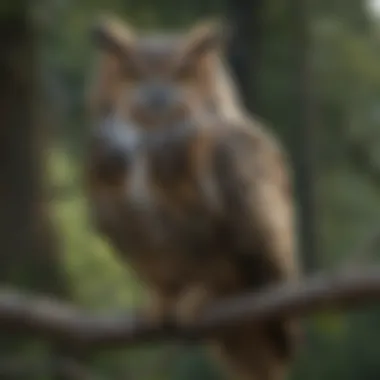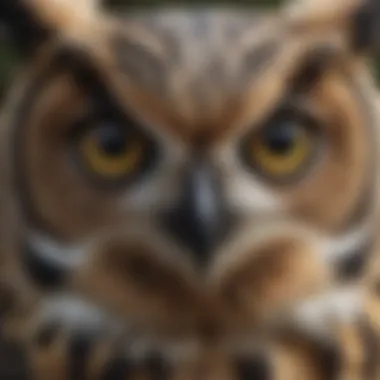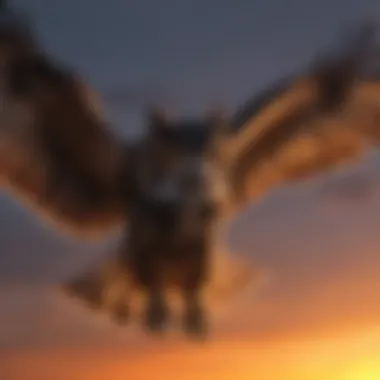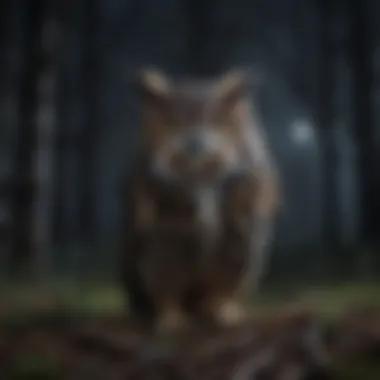Discovering Intriguing Facts About the Majestic Great Horned Owl


Overview of the Topic
In the vast tapestry of the natural world, the great horned owl stands as a symbol of mystery and mastery. This majestic bird of prey, with its notable tufts of feathers resembling horns, captivates the imagination of all who encounter it. From the hooting calls echoing through the night to its silent flight in search of prey, the great horned owl holds a commanding presence in various ecosystems across North and South America.
Physical Characteristics
One of the most remarkable aspects of the great horned owl lies in its physical characteristics. With a wingspan reaching up to 5 feet and sharp talons designed for grasping and subduing prey, this avian predator strikes a formidable figure. Its large, forward-facing eyes provide exceptional night vision, allowing it to navigate the darkness with ease. The intricate patterns of mottled brown and white feathers serve as potent camouflage, helping it blend seamlessly into its woodland habitats.
Hunting Behavior
When dusk descends and darkness blankets the land, the great horned owl emerges as a skilled nocturnal hunter. With silent wingbeats and acute hearing, it swoops down on unsuspecting prey ranging from small rodents to larger mammals. Its talons strike with deadly precision, ensuring a swift and efficient capture. Through this intricate dance of flight and hunt, the great horned owl reaffirms its position as a top predator in its ecosystem.
Significance in Ecosystems
The presence of the great horned owl reverberates throughout the ecosystem, influencing the population dynamics of prey species and contributing to the balance of nature. By controlling small mammal populations, it helps regulate the spread of diseases and maintains the health of local habitats. As a keystone species, its role in the food web is irreplaceable, showcasing the interconnectedness of all living organisms in a delicate ecological tapestry.
Conservation Efforts
Despite its adaptability and resilience, the great horned owl faces challenges from habitat loss, human encroachment, and environmental pollution. Conservation efforts play a crucial role in safeguarding this magnificent bird and its critical role in maintaining ecosystem stability. Through habitat protection, education initiatives, and research advancements, conservationists strive to secure a sustainable future for the great horned owl and the habitats it depends on.
Conclusion
Upon embarking on a journey to explore the magnificent world of the great horned owl, one quickly realizes the significance of this majestic bird of prey in the intricate tapestry of nature. As a formidable predator, the great horned owl embodies grace, power, and resilience, captivating the attention of conservationists, students, and environmentalists alike. By delving into the depths of this avian marvel, one gains a profound appreciation for the vital role it plays in its ecosystem.
The introduction serves as a gateway into a realm where physical prowess and strategic hunting abilities converge in perfect harmony. By shedding light on the impressive wingspan and the distinctive facial disk of the great horned owl, readers are primed to delve deeper into the intricacies of this aerial predator's anatomy and behavior. Understanding these physical characteristics is crucial in decoding the survival strategies employed by the great horned owl in its natural habitat.
Infused with mystery and intrigue, the great horned owl's habitat and distribution unveil a mosaic of diverse environments where this adept hunter thrives. From the lush woodlands to the urban landscapes, the adaptability of the great horned owl to various regions is a testament to its resilience and flexibility. By elucidating the preferred environments and global range of this majestic bird, readers embark on a virtual expedition across continents, unraveling the secrets of its nomadic existence.
Behavior and diet showcase the great horned owl's prowess as an apex predator, utilizing silent flight and powerful talons to secure its prey with precision and stealth. The nuanced hunting techniques and varied diet of this avian carnivore paint a vivid picture of its predatory instincts and adaptability to changing environmental conditions. By exploring the intricacies of its hunting behavior, readers gain a deeper insight into the dynamic relationship between predator and prey in the natural world.
Reproduction and life cycle illuminate the intimate details of the great horned owl's breeding habits and the development of its young. Through the lens of monogamous pairs and rapid growth, readers uncover the familial bonds and nurturing instincts that define the reproductive journey of this majestic bird. Witnessing the early hunting skills of the young owlets underscores the evolutionary adaptations that ensure the survival of the species across generations.
As the narrative unfolds towards interaction with humans, readers are immersed in the cultural significance and conservation challenges faced by the great horned owl. From symbolisms ingrained in various cultures to the imminent threats posed by habitat loss, the intricate dance between humans and wildlife takes center stage. By dissecting the delicate balance between progress and preservation, readers are compelled to contemplate their role in safeguarding the future of these magnificent birds.
Physical Characteristics


As we delve into the intriguing world of the great horned owl, it is vital to understand the significance of its physical characteristics. The features of this majestic bird play a crucial role in its survival and hunting prowess, making them a focal point of interest for researchers, conservationists, and nature enthusiasts. From its imposing size to the intricate details of its feathers and coloration, each aspect offers insights into the adaptation and evolution of this formidable predator.
Size and Appearance
When we consider the great horned owl's size and appearance, two key elements come to the forefront: the impressive wingspan and the prominent ear tufts. The impressive wingspan of the owl serves as a defining characteristic that enables silent flight and precise hunting maneuvers. This feature plays a pivotal role in the owl's ability to navigate diverse habitats and spot potential prey from great distances. Additionally, the prominent ear tufts, though not actually connected to the owl's ears, are believed to serve as a form of camouflage and aid in communication and expression. These tufts add to the owl's majestic appearance and contribute to its overall presence in the wild.
Feathers and Coloration
The feathers and coloration of the great horned owl are intricately designed to provide both camouflage and visual appeal. The camouflaging plumage of the owl allows it to blend seamlessly into its surroundings, a crucial adaptation for hunting and avoiding predators. The distinctive facial disk, a unique feature that aids in sound localization, also plays a role in enhancing the owl's camouflage and serving as a means of intimidation towards rivals. The color variations in the owl's plumage serve as a visual representation of its adaptability to different environments, showcasing nature's exquisite craftsmanship in equipping this bird with the tools necessary for survival and success.
Habitat and Distribution
Great Horned Owls possess a wide habitat range, showcasing their adaptability to various environments. Understanding their preferred habitats provides insights into their survival strategies and ecological significance. These owls are found in diverse habitats, including forests, deserts, and urban areas. Such diverse habitats highlight their ability to thrive in different conditions, showcasing their remarkable resilience and flexibility. The unique feature of diverse habitats lies in the exposure to varying prey species, enabling the owls to demonstrate their hunting prowess effectively.
Adaptability to various regions further enhances the Great Horned Owls' distribution across North and South America. Their ability to acclimate to changes in climate and vegetation contributes to their widespread presence in both urban and rural settings. The adaptability of these owls to various regions underscores their successful colonization of diverse landscapes. Despite potential challenges, such as habitat destruction and human interference, their adaptability ensures their continued existence in different habitats.
Preferred Environments
Diverse habitats
The Great Horned Owl's ability to inhabit diverse habitats is crucial to their survival and hunting success. These environments provide an array of prey options, including small mammals, birds, and even reptiles. The varied landscapes offer ample opportunities for hunting, allowing the owls to capitalize on their predatory skills effectively. The richness of diverse habitats ensures a steady food supply, essential for sustaining these apex predators.
Adaptability to various regions
The Great Horned Owl's adaptability to various regions is a testament to their resilience and evolutionary prowess. By thriving in different ecosystems, from temperate forests to arid deserts, these owls exhibit remarkable versatility. This adaptability enables them to respond to changing environmental conditions, ensuring their survival amidst human encroachment and habitat degradation. Their presence in urban areas further showcases their adaptability, as they navigate man-made landscapes while maintaining their predatory efficiency.
Global Range
North and South America
The distribution of Great Horned Owls across North and South America highlights their importance in maintaining ecosystem balance. These regions offer a mix of habitats, ranging from dense forests to open plains, providing the owls with a varied hunting ground. The geographic expanse of North and South America allows for the owls' territorial expansion and breeding success, essential for their species' continuity. Despite facing threats from urbanization and deforestation, these owls persist in adapting to the challenges posed by human impact.
Presence in urban areas
The Great Horned Owl's presence in urban areas signifies their ability to coexist with human development. Their adaptation to urban environments showcases their resilience and opportunistic behavior. By utilizing urban parks and green spaces as hunting grounds, these owls demonstrate their capacity to thrive in man-modified landscapes. However, this urban presence also exposes them to risks such as vehicle collisions and habitat fragmentation, emphasizing the importance of conservation efforts to safeguard their populations.
Behavior and Diet


When delving into the world of the great horned owl, understanding its behavior and diet is paramount. This section sheds light on the intricacies of how these majestic birds interact with their environment and secure sustenance. By exploring their hunting techniques, one can appreciate their role as top predators in the ecosystem. The behavior and diet of the great horned owl offer a glimpse into their adaptability and efficiency in hunting for survival.
Hunting Techniques
Silent Flight
Silent flight is a crucial aspect of the great horned owl's hunting prowess. This specialized skill allows them to approach their prey stealthily, without producing the typical wing sounds that might alert potential victims. By dissecting the mechanics of silent flight, we uncover the evolutionary advantages that enable these owls to capture prey with remarkable precision. The absence of noise during flight enhances their effectiveness as predators in various environments.
Powerful Talons
The powerful talons of the great horned owl are instrumental in capturing and disabling prey. These sharp claws exhibit incredible strength, enabling the owl to grasp and subdue a wide range of animals for consumption. By examining the anatomy of the owl's talons, one can grasp the adaptations that make them formidable hunters. The ability to exert force through their talons highlights the evolutionary adaptations that have honed the great horned owl into a proficient predator.
Prey Selection
Varied Diet
A diverse diet is a hallmark of the great horned owl's survival strategy. Their ability to consume a wide array of prey species underscores their adaptability and resilience in different habitats. By exploring the components of their varied diet, we unravel the sophisticated palate of these raptors and the ecological impact of their feeding habits. The diverse diet of the great horned owl showcases their position as versatile hunters with a global appetite.
Ability to Take Down Large Animals
The great horned owl's capability to tackle large animals sets it apart as a formidable apex predator. Through a closer examination of their technique for capturing sizable prey, we appreciate the immense strength and precision required for such feats. The evolutionary advantage of being able to take down large animals speaks to the prowess and strategic hunting skills of these majestic birds. Their ability to target and conquer sizeable prey items elucidates the successful predatory traits that have allowed the great horned owl to thrive in diverse ecosystems.
Reproduction and Life Cycle
Exploring the intricacies of the great horned owl's reproduction and life cycle provides a profound insight into the perpetuation of this magnificent species. Understanding how these remarkable birds reproduce and nurture their young adds a layer of depth to appreciate their role in maintaining ecological balance. The reproductive behavior and life stages of the great horned owl are crucial aspects that showcase nature's resilience and intricacy, making it a topic of significant importance in this article.
Breeding Habits
Monogamous Pairs
Delving into the world of monogamous pairs in great horned owls unveils a fascinating aspect of their breeding habits. The commitment to a single partner throughout breeding seasons underscores the loyalty and connection between mates, fostering a stable environment for successful reproduction. Monogamous pairs symbolize dedication and cooperation, essential for raising healthy offspring and maintaining genetic diversity within the population. This behavior enhances the article's focus on the breeding habits of great horned owls, emphasizing the importance of long-term partnerships in their reproductive success.
Nesting Behavior
The nesting behavior of great horned owls offers a glimpse into their nurturing instincts and habitat requirements. Selecting suitable locations for nest building demonstrates their adaptation to diverse environments and their ability to ensure the safety of their young. The meticulous construction of nests reflects the strategic planning and protective nature of these birds, optimizing the survival chances of their offspring. Understanding the significance of nesting behavior enriches the discussion on the reproductive strategies employed by great horned owls, highlighting the pivotal role of nest sites in their breeding success.


Development of Young
Rapid Growth
The rapid growth observed in young great horned owls is a testament to their resilience and genetic programming for survival. Their accelerated development from hatchlings to fledglings showcases nature's efficiency in preparing them for independence. The rapid growth rate facilitates their ability to adapt to various challenges in the wild, ensuring their physical fitness and eventual integration into the ecosystem. This section elucidates the remarkable transformation of young great horned owls, shedding light on the dynamic nature of their developmental milestones.
Early Hunting Skills
The early development of hunting skills in juvenile great horned owls exemplifies their instinctual prowess and adaptive capabilities. Acquiring essential hunting techniques at a young age equips them with vital survival tools for procuring food and establishing their predatory skills. The early mastery of hunting enhances their self-sufficiency and predatory efficiency, setting the foundation for their role as formidable hunters in the ecosystem. Examining the evolution of early hunting skills in young great horned owls underscores their remarkable growth trajectory and underscores the importance of honing innate abilities for survival in the wild.
Interaction with Humans
In delving into the world of the great horned owl, it is essential to understand the impact of human interaction on these majestic birds. The relationship between humans and owls holds significant importance in conservation efforts and ecological balance. By studying how humans influence owl behavior and habitat, conservationists and researchers can develop strategies to protect these remarkable creatures.
Cultural Significance
Symbolism in Various Cultures
One of the fascinating aspects of the great horned owl is its symbolism in various cultures. Across different societies, the owl is often associated with wisdom, mystery, and intuition. This symbolism reflects the owl's nocturnal nature and keen hunting skills, which have inspired awe and reverence in cultures worldwide. The owl's presence in folklore and myths as a wise and elusive creature adds depth to human stories and conveys a sense of connection to the natural world.
Depictions in Folklore and Art
The depiction of owls in folklore and art further highlights their cultural significance. In myths and legends, owls are portrayed as symbols of knowledge, intelligence, and foresight. Artists throughout history have been captivated by the owl's enigmatic charm, incorporating its image into paintings, sculptures, and literature. These artistic representations serve to immortalize the owl's mystique and evoke a sense of wonder and respect for these iconic birds.
Conservation Status
Threats to Population
Despite their cultural importance, great horned owls face various threats to their population. Habitat loss, human disturbances, and pesticide contamination are among the primary challenges impacting owl numbers. By understanding these threats, conservationists can implement measures to mitigate human-induced risks and ensure the long-term survival of these magnificent birds.
Importance of Habitat Preservation
Preserving habitats is crucial for the conservation of great horned owls and other wildlife species. Healthy ecosystems provide essential resources for owls, including food sources and suitable nesting sites. By emphasizing the importance of habitat preservation, conservation initiatives can safeguard biodiversity and promote sustainable coexistence between humans and owls.
Conclusion
The great horned owl, with its formidable presence in various ecosystems, holds a significant importance in the realm of avian predators. Throughout this article, we have delved into the intricate details of the great horned owl's physical characteristics, habitat preferences, behavioral patterns, and its interactions with humans. By exploring these facets, we have uncovered not just facts, but a deeper understanding of the dynamics that shape the existence of this majestic bird.
One of the key elements highlighted in this article is the remarkable adaptability of the great horned owl. From its diverse range of habitats, spanning from North to South America and even urban areas, to its ability to take down large prey with precision, the owl demonstrates a remarkable level of versatility in its survival strategies. This adaptability emphasizes the bird's exceptional skills for thriving in a changing environment, making it a valuable subject for ecological studies.
Furthermore, the great horned owl's cultural significance cannot be overlooked. Symbolism attached to this predator in various cultures, as well as its portrayal in folklore and art, showcases the deep-rooted connection between humans and nature. By understanding and appreciating this cultural importance, we not only gain insights into ancient beliefs and traditions but also recognize the significance of maintaining harmony between humanity and the natural world.
In terms of conservation, shedding light on the threats facing the great horned owl population is crucial. Factors such as habitat loss, human encroachment, and environmental degradation pose significant challenges to the owl's survival. By underscoring the importance of habitat preservation and raising awareness about the need for conservation efforts, we can contribute to safeguarding the future of this iconic bird.



